Getting Started With Algorithmic Design In Architecture in 2025: A Comprehensive Guide
Table of Contents
The digital boom has brought us many new technologies that show us what we have been missing. Algorithmic design is not exactly new, but it is only recently that the interest in it has taken off. Industry professionals are still familiarising themselves with the new technology, resulting in much confusion and challenges in its adoption. In architecture, algorithms have become increasingly crucial due to their ability to optimise daylighting, ventilation, and thermal performance to facilitate sustainable and energy-efficient designs.
Complex geometries and freeform shapes, once difficult to design and construct, are now achievable through algorithmic modelling and analysis, enabling mass customisation of building components. As technological advancements continue and the demand for sustainable, efficient, and innovative architectural solutions grows, the importance of algorithmic design is poised to become even more pronounced in 2024 and beyond.
In this comprehensive guide, we first define algorithmic design, compare it with other computational design approaches, and discuss the potential and limitations of implementing it in architecture.
What Is Algorithmic Design?
The AEC industry is finally embracing the potential of digital technologies in design and construction, as proven by the adoption of BIM (Building Information Modelling) and computational design in the past decade. As the popularity grows, more subsets are derived, and more definitions arise as the industry tries to understand this complex niche. It also does not help that the scope of some of these subsets overlap.
Therefore, before we go any further about what algorithmic design can do, a clear definition of it is imperative.
Algorithmic design is based on a defined and logical set of rules and programs. It generates output that incorporates computational complexity for architectural programs and expressions. This approach allows architects and designers to rationalise, analyse, and iterate through a defined methodology.
It is a true CAD (Computer-Aided Design)—the computer aiding the logical process of the mind to create the output. The CAD tools we know of only help us create the 2D and 3D drawings of the design conjured in our minds. Algorithmic design tools bridge the gap between the mind and the computer so that both are conjuring the design together.
The Origin Of Algorithms In The Architecture And Design Field
Algorithms are not a recent discovery. The concept has been around for centuries. However, it is with the advancement of computational technology that the awareness of it also became prominent.
These algorithms define the information input and the logical process behind design decisions. They are a finite sequence of rules that solves a design problem in the design development. Interestingly, the exploration of algorithms in architecture was motivated by the increasing complexity and scale of the designs today. Architects, in any way, want to avoid more complexity in their workflows, but now they are willing to explore algorithms and computation for their generative capabilities.
And why wouldn’t they? Algorithms can provide architects with better aesthetics, better performance and sustainability, all the while, automating laborious tasks.
How Is Algorithmic Design Different From Other Computational Designs?
What Is Computational Design?
To explain in the easiest way, computational design is the use of computation for a logical process to design. Architects have relied on intuition and trial-and-error methods to design; computational design streamlines the process of solving design problems with a computer language that takes a mathematical and logical approach. In reality, computational design is so broad of a term that there is still no concrete definition of it in the industry. Moreover, it is not just a single process. It has several subsets that make use of the above-mentioned process in different approaches.
Algorithmic vs. Parametric And Generative
There is a lot of overlap for all these terms, hence creating an ambiguous definition in relation to computational design. Algorithmic, parametric and generative designs are all subsets under the umbrella of Computational Design. There are more of these subsets, but these 3 are the most commonly discussed and used in the industry (We have previously discussed the definitions of computational, parametric, and generative design).
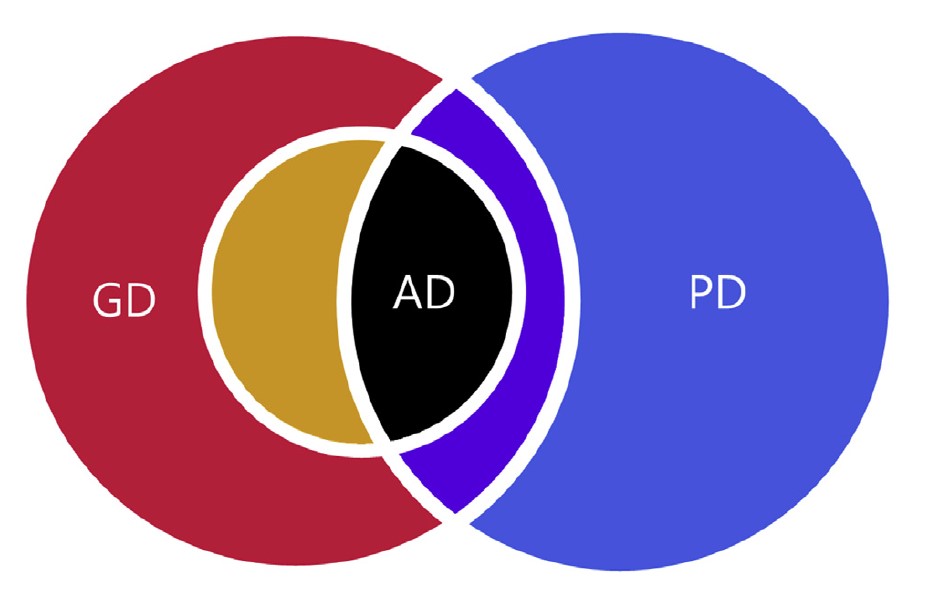
Generative design, on the other hand, is trickier to define precisely. Many consider it the same as algorithmic design as it requires algorithms for the processes. However, it is more accurate to state that there is only a close relationship between these two design approaches. Generative design is a process that utilises computational algorithms to generate design iterations based on specific constraints.
Read more: Benefits of emerging Computational design developments in the AEC industry
The Difference Between An Algorithm & A Parameter
Algorithmic and parametric design are often confused with each other. As much as the terms algorithmic and parametric design have been misused, their base terms, algorithm and parameter, need to be paid close attention to in order to understand the difference.
In parametric design, the parameters are the deciding factors for the design output. We set and manipulate the parameters using a computational script, usually via visual programming, to obtain the parametric design iteration.
Let’s make this simple – parameters are usually existing conditions in the model while algorithms are rules. Both can be at work concurrently.
Direct Modelling vs. Computational Modelling
Working with algorithms is a huge contrast from the usual modelling most of us are familiar with. Conventional modelling in software such as Sketchup, 3ds Max and Revit is known as direct modelling. No algorithms or parameters for design iteration are involved.
To work with computational modelling, add-ons and plugins are necessary to enhance the functionality of the software. For example, Revit has Dynamo and Rhino.Inside.Revit for computational features.
Rhino 3D and Grasshopper are the primary tools associated with algorithmic design and even for parametric and generative designs. More tools are available via the Grasshopper interface, so if you are interested in parametric and algorithmic modelling, it is the best tool to know. We develop and generate the output by primarily using visual programming languages.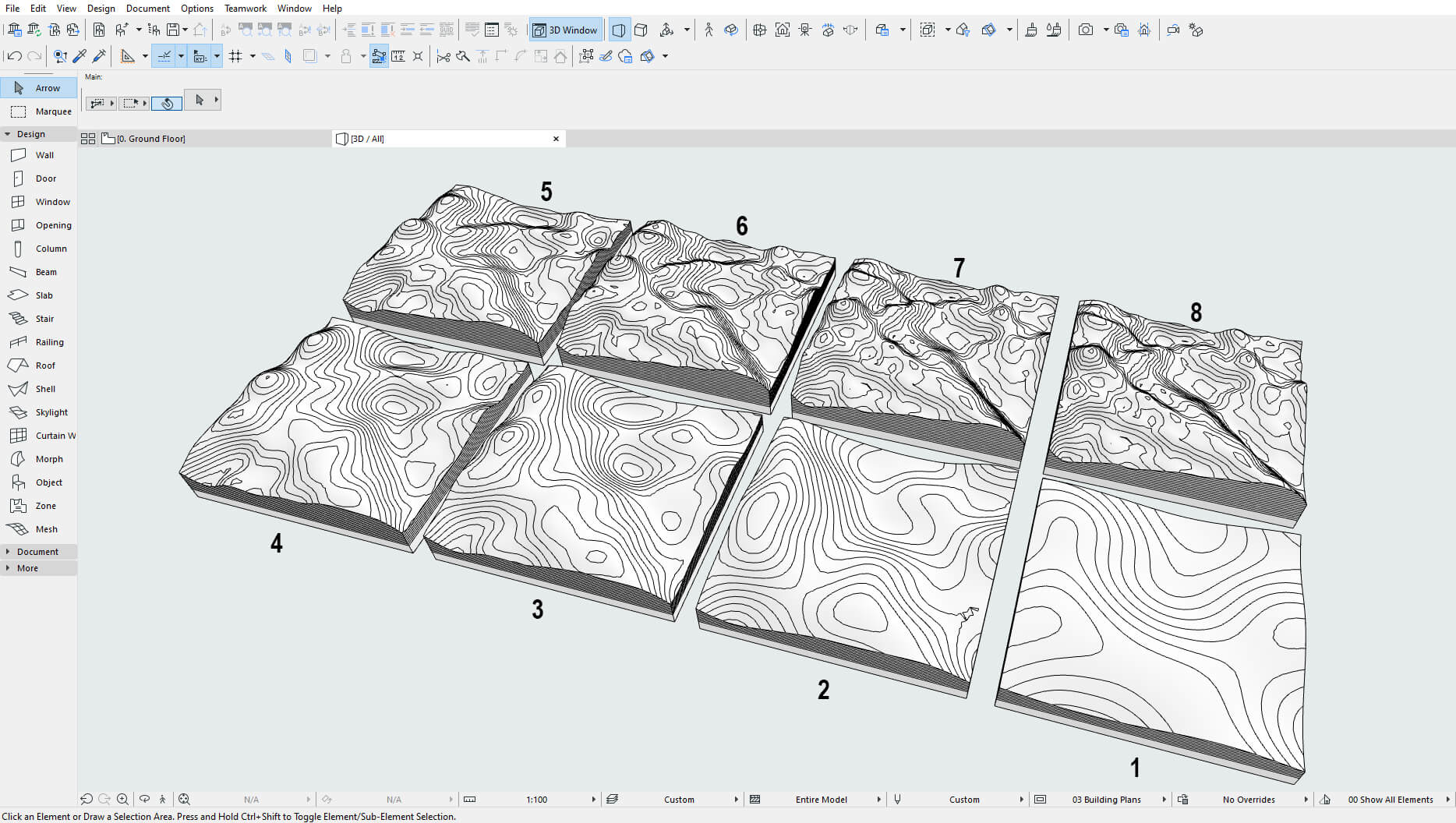
Algorithmic Design In Architecture
How Can Algorithms Help Architects?
Algorithmic design, as with all other computational design approaches, opens new doors for architectural design form and expression. Why do we mostly see dynamic and complex forms when talking about computational design? These structures are in fact a proof of the potential of computational design approaches and tools.
Case Study: Mars Office For Autodesk By The Living
A project back in 2019 by The Living, backed by Autodesk and Princeton University, employed generative and algorithmic design to plan the office space for Autodesk in Toronto. High-level goals and constraints were set and using computation, the team was able to explore and identify the best design option. The first constraint was the number of floors in the building which was set to 3 floors. The second set of constraints was more diverse – it included programmes, spaces and the number of people. These constraints became the algorithms that generated thousands of floor plan iterations for the office.
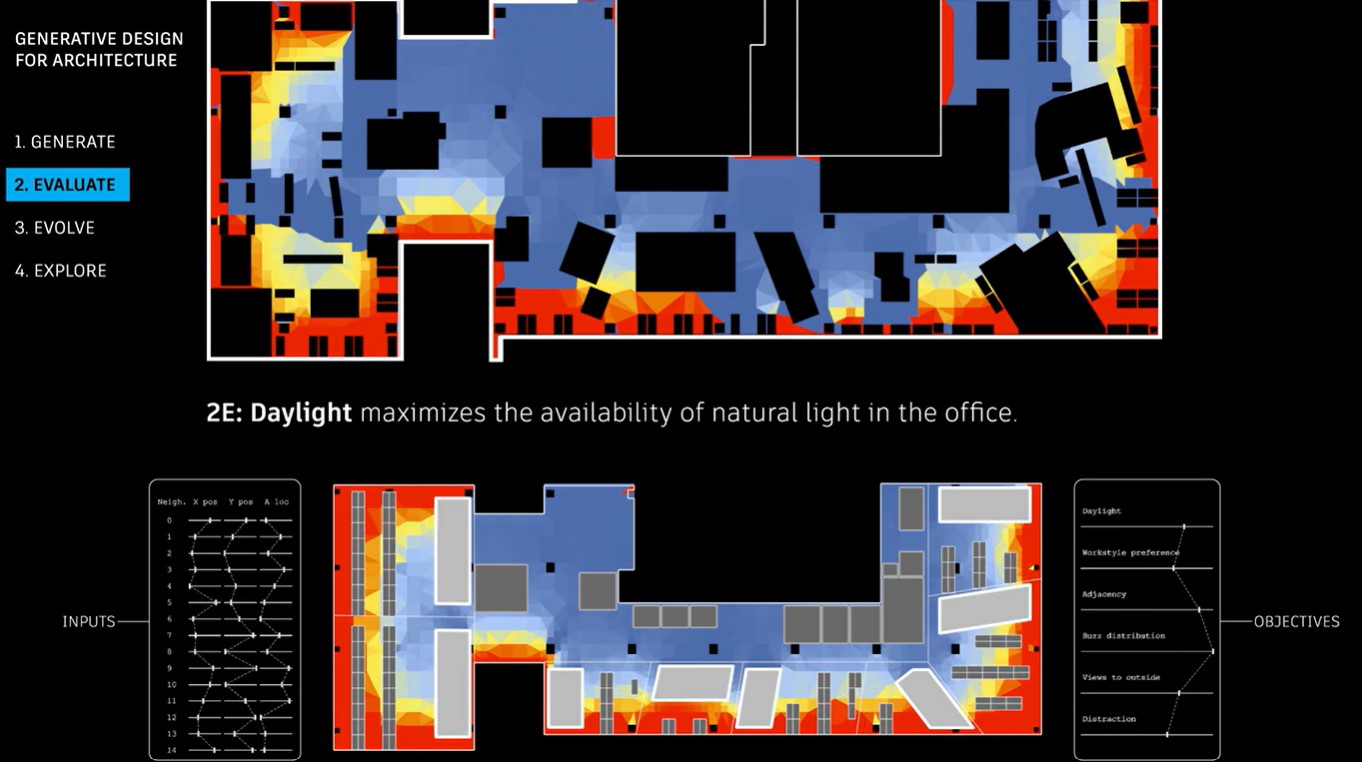
- Adjacency preference
- work style preference,
- views,
- buzz,
- productivity
- daylight
Any necessary data was collected from the occupants which allowed the designers to understand the complexity of the human experience better. Algorithms come into play when measuring these 6 variables. Thousands of design options were automatically created using these algorithms, giving the stakeholders the capacity to review and refine the optimised design.
Algorithms For AI
The best example of algorithmic design for architecture is the new trend of AI images. While there are many speaking of the possible negative effects on the profession, we can all agree that AI has produced stunning aesthetics in architecture.
This recent trend has divided the industry into two groups; one that supports the reliance on AI to design and the other opposing. The argument is that it is not the architect who is actually creating the design, which also raises the concern that we may no longer need architects for design.
However, those who support the use of AI in architecture justify that a building needs more than just aesthetics and that computational design and AI can optimise the design output and process. Nonetheless, AI, especially image generation, has dominated the buzz in the design industry since 2022.
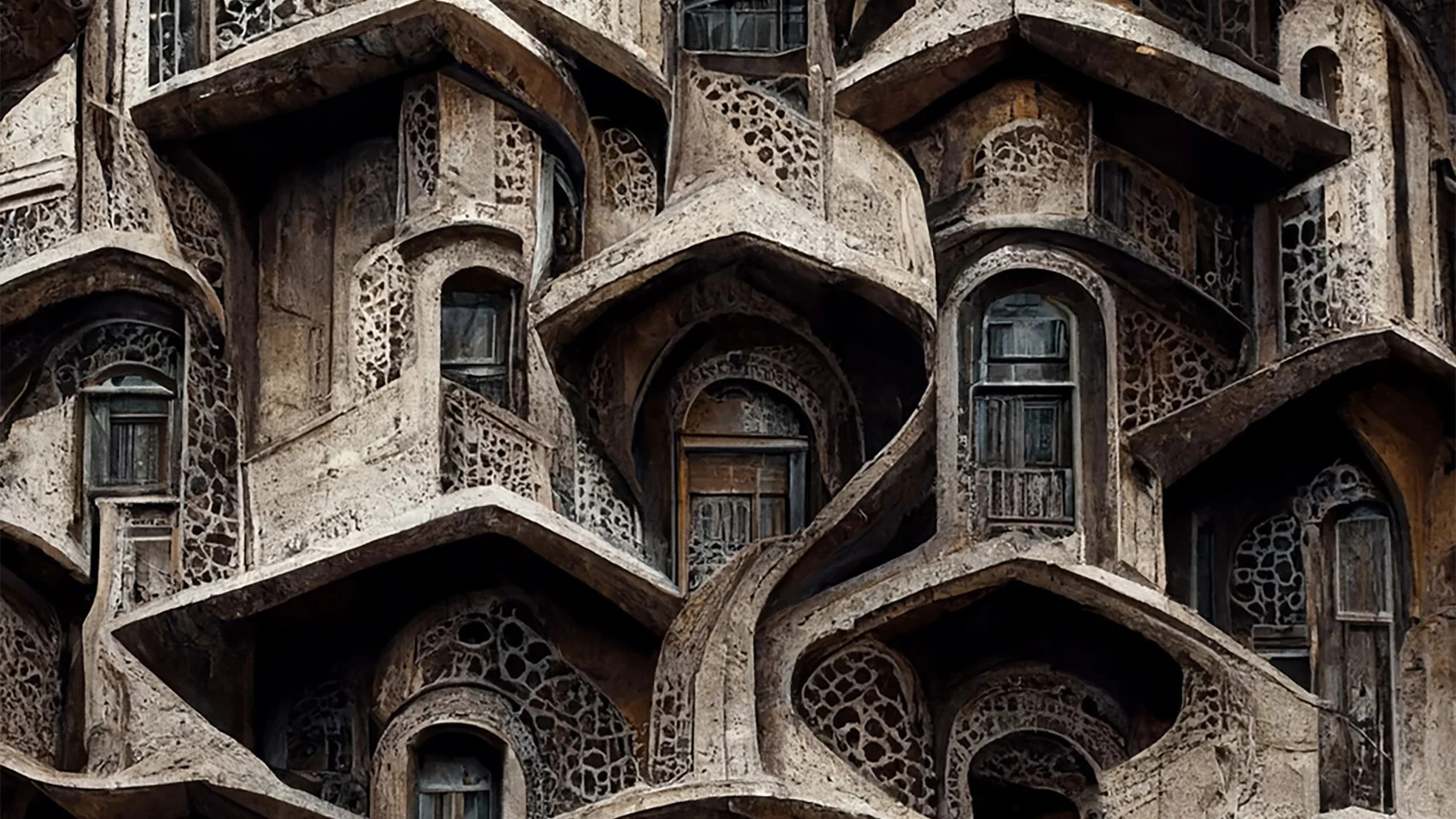
Using Algorithms For Analysis
The use of algorithmic design is not restricted to the architecture and construction industry, nor is it only for designing.
Computational design tools have now merged with numerous building performance analysis and simulation tools to give architects the ability to analyse their designs based on algorithms and parameters.
Solar radiation and energy analysis are common analyses necessary for an energy-efficient design. Architects can now run simulations and analyses during the design development stage using parametric and algorithmic processes, with the aid of visual programming, and iterate design options based on the results.
Why Should Architects And Designers Know Algorithmic Design?
Efficiency
It is only right to start off its list of benefits with efficiency. The design iterations an algorithmic design program can produce in a short time are immense, improving productivity with fewer resources. Having the iterations is not enough; architects should be able to make informed decisions for the best design. These tasks may sound simple in words, but in reality, they can take ages without the assistance of algorithms.

Going back to our MaRS Office by The Living example, the generative and algorithmic processes could automatically create thousands of iterations in a short time while still meeting all the complex constraints. Although the exact duration depends on many factors, it is undeniable that the generative process is much faster for a project that would otherwise take aeons to complete.
You don’t even need to know highly complex tools. Let’s say you are manually creating different design options for floor plans in Revit, modelling and drawing to no end to get the most suitable one for your programs and users. Incorporate Dynamo or Grasshopper, and play around with the visual scripts. You will have hundreds of these options in no time.
Automation
Another great benefit of algorithmic and computational design is their ability to automate tasks. For example, we can easily iterate a hundred iterations of a 3D model in Grasshopper just by tweaking the visual script a few times. You don’t even need to do it for all hundreds!
Automation also comes in handy when handling repetitive tasks. Imagine you have to update the dimensions in a model. Just one or two is easy. But what if you have 80 dimensions that need to be updated? An algorithm can modify all 80 dimensions.
More Precision At A Lower Price
Automation and the overall efficiency of computational design can reduce project costs and other resources, including the number of staff working on a project. Moreover, the precision offered by algorithmic design ensures an error-free design that mitigates design risks and reduces unnecessary costs.
Plan For A Freelance Career
As a professional in the design industry, skills in algorithmic design and other computational methods give you an upper hand in understanding design and a better career path. You can even opt to freelance in the industry since you are - capable of handling even the most complex tasks with the aid of computational design.
Are you planning to freelance?
Read more: How is Computation used in Stadium Design in 2024?

Challenges In Adopting Algorithmic Design In Architecture
The Learning Curve
It is undeniable that all computational design processes have a steep learning curve. The same goes for algorithmic design. You need to understand the methodology as well as the software and plugins. Learning the visual programming language is the next part. Though it is not as difficult as non-visual programming languages, a beginner can find the learning process an upward climb - but only in the beginning.
Read more about visual programming tools and languages here.
The Reluctance To New Technologies
Similar to BIM, many architects are still reluctant to adopt new technologies. In a way, this gives a skilled professional an upper hand. However, if you work for a firm that refuses to use computation, you are most likely to be stuck with repetitive tasks. The steep learning curve is a contributing factor to this reluctance.
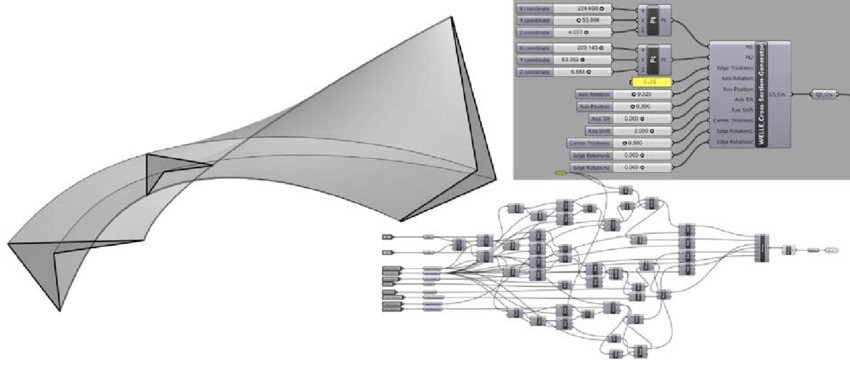
Are Algorithms The Future Of Architecture And Building Design?
The Creative Freedom Gives Infinite Possibilities
Since the late 80s, the architecture scene worldwide has seen an exponential growth of organic forms for buildings and structures. Straight lines and right angles no longer bind us. But are we at a dead end of creative architectural design? We are far from it.
The use of algorithms and computation has given architects what might possibly be just what they need most—creative freedom. We can only expect to see more architects exercising their creative freedom to full effect, giving us new organic forms that were once thought impossible.
Getting Involved In Spatial Exploration
Algorithms do not just give us forms but also spatial layouts based on the exploration of real conditions. The spatial layout of the MaRS office example above is such a case—algorithms determine the layout of offices and the furniture based on several factors. The result is the best-optimised office space that promotes the comfort and productivity of the occupants.
Extending The Capabilities Of Architects
We have talked so much about how algorithms will design buildings of the future, but let us not forget that algorithms are only aiding the architects. The job of designing still lies on the architect. Algorithms extend the capabilities of the architects to think logically to solve design problems. With the rapid developments and their complexities, architects will surely require algorithms for design developments.
Conclusion
We can conclude that algorithms will remain present in our lives and in our designs. Despite the worry that technology will soon replace architects, it is becoming mandatory in our lives. So are algorithms, with all the benefits they provide are slowly changing the mindset of the industry. Algorithmic design is more than just a buzzword with a futuristic tang – it has already made invaluable contributions to the design and construction industry.
Algorithmic design and all other computational approaches may seem complex, but your learning doesn’t have to be. Master Computational Design Course For Real World Application with Novatr, taught by industry experts from top AEC firms, and accelerate your career in the architecture and design industry.
Our Resources page contains more comprehensive guides on BIM, Parametric design, and Generative design. To stay current with industry trends and insights, follow us on Instagram and YouTube.

 Thanks for connecting!
Thanks for connecting!

%20(1).png)
%20(1).png?width=767&height=168&name=MCD%20B%20(Course%20Banner)%20(1).png)
.png)

%20-%202023.jpg)


.jpg)
